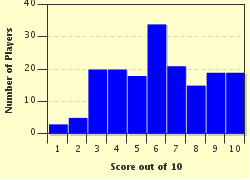Quiz Answer Key and Fun Facts
1. Glider pilots think this type of cloud is great but pilots of powered aircraft stay away from them. What are they called?
2. Technically, this is a cirrocumulus or altocumulus cloud, but what is the folkname given to this type of cloud?
3. Here's one that made our ancestors quail. It may be called a halo or sunbow. What is the name of the cloud that causes it?
4. What is this particular type of cumulonimbus cloud called?
5. It may look like benign weather in this picture but it won't be for long. What is the colloquial name for this type of cirrus cloud?
6. This type of cloud can cover large distances and sometimes the whole sky. It's name is taken from Latin. Do you know what it is?
7. You can tell it will be a nice day here because of the fair-weather clouds in the sky. What is their name?
8. Yes, that really is a cloud formation. Can you guess what its name is?
9. You're right, this is fog. Okay, smarty, fog forms when there is very little difference between air temperature and what?
10. What time is it if you see a cloud like this? It's time to take cover! What is this cloud type known as?
Source: Author
CmdrK
This quiz was reviewed by FunTrivia editor
rossian before going online.
Any errors found in FunTrivia content are routinely corrected through our feedback system.

